1 The essence of the surgical intervention
The operation is carried out in several stages:
- Treatment of the zone of operation with disinfecting solutions( alcohol and iodine).
- Use of local anesthesia. More often the patient is given a 0.5% or 0.25% solution of novocaine. Complicated operations are performed under general anesthesia.
- Opening the peritoneum by means of an oblique cut of the skin on the groin line to the right.
- Detection and amputation of a part of the caecum.
- Checking the function of the abdominal organs and stitching the incision.
- Overlapping the dressing.
Do you have gastritis?
GALINA SAVINA: "How easy is it to cure gastritis at home for 1 month." The proven method is to write down a recipe. ..! "Read more & gt; & gt;
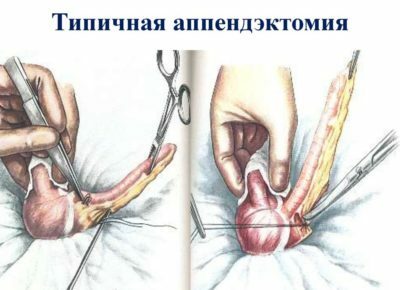
Recommended to read
- Life with an ostomy after an operation on the intestine
- Symptoms of adhesions after an appendicitis
- How is an examination at a gastroenterologist's reception: who is he and what heals
- The effective remedy for gastritis and stomach ulcer
When performing surgery and then removing the appendix, the followingspecialists:
- anesthesiologist - a physician responsible for the procedure of anesthesia during surgery;
- surgeon - specialist, performing appendix removal;
- doctor or nurse - assist in the operation, performing various manipulations.
It is the nurse's responsibility to monitor the condition of the operated patient during and after the operation. It is necessary to pay attention to the speed and rhythm of the pulse, the functions of the gastrointestinal tract and language. Surgical intervention is a complex process in which the following tools and materials are used:
- scalpel and scissors;
- clamps for stopping bleeding;
- surgical needles and needle holders;
- anatomical and surgical tweezers;
- sharp and blunt forceps;
- hooks for expanding the peritoneal incision;
- silk and catgut.
After completing the operation, the appendix is sent to the histology for additional tests. In the postoperative period, the use of enemas and preparations diluting feces is indicated. You can not do sharp movements or get up quickly. After the procedure for the removal of the appendix, it is important to follow the regimen and follow the recommendations of the attending physician.
2 Types of Operations
How is antegrade appendectomy performed? On the caudal part of the small intestine, on the mesentery, a terminal is fixed. At the base of the appendix is a puncture through which a barrier is created in the gut. Then the gut is bandaged with a silk thread. If there are puffiness or creases in the area of the joint of the organs, several clamps should be applied in different places.
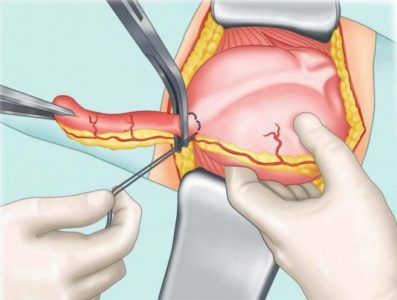
A groove is formed several times by fixing the clamps, a catgut ligature is next to it. The next step in the operation to remove the appendix is suturing. The cystic serous-muscular suture should be applied in 1 centimeter from the base of the intestine. A clamp is fixed above the catgut ligature, and the appendix is cut out.
-
 IMPORTANT TO KNOW! Gastritis? Ulcer? To have a stomach ulcer not turned into cancer, drink a glass. ..Read the article & gt; & gt;
IMPORTANT TO KNOW! Gastritis? Ulcer? To have a stomach ulcer not turned into cancer, drink a glass. ..Read the article & gt; & gt;
Then the cut off edges of the appendix fall into the cecum and muslin suture. The final step of the operation is a delicate extraction of the clamp and the imposition of a 3-shaped serous-muscular suture. Retrograde appendectomy is performed if difficulties arise with access to the appendix and its removal to the wound. The operation is indicated if: spikes have formed in the abdominal cavity of the
- ;The
- appendix is retrocecal or retroperitoneal.
In the area of the base of the ctenoid process( through the puncture), the mesentery ligature is fixed in the mesentery. Then appendicitis is removed and stitches are applied, and the peritoneum is dried using tufts or an electric pump. In most cases, the seams are superimposed without the possibility of re-overlapping.
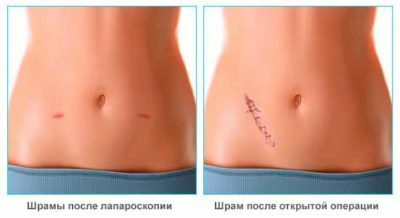
3 Performing drainage
Peritoneal drainage is carried out if: the patient is diagnosed with
- peritonitis;
- has doubts that the vermicular organ has been removed completely;
- the patient developed a periapendicular abscess - an inflammatory process in the abdominal cavity;
- the trimmed edges of the appendix were improperly sewn.
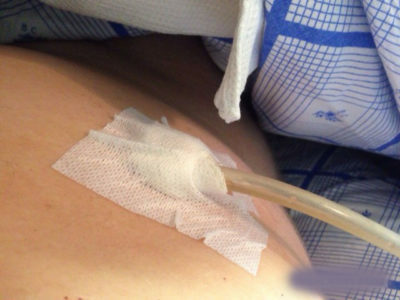
The procedure itself is carried out by means of another notch by means of a tubular hose, at the end of which there are several holes. With peritonitis, two drainage devices are fixed:
-
 Gastroenterologist. IMPORTANT: "I beg you, if you began to worry about abdominal pain, heartburn, nausea, do not do gas in any way. .."Read more & gt; & gt;
Gastroenterologist. IMPORTANT: "I beg you, if you began to worry about abdominal pain, heartburn, nausea, do not do gas in any way. .."Read more & gt; & gt;
- large - in the area of the appendix and pelvis;
- small - at the side channel on the right.
In other cases, specialists install one large drainage device( in the pelvic area and in the operation area).A patient may be assigned a laparoscopic operation, which is performed in the presence of adhesive processes. When treated with standard methods, there is an increased risk of inflammatory and purulent processes.
Laparoscopy allows you to recover faster after surgery. More often pathologies of the vermiform organ arise due to the development of inflammation of the appendix. The procedure of laparoscopy is contraindicated if the patient has strong adhesive processes or any serious accompanying pathologies. For the operation on the skin, several punctures of different diameters are made:
- in the navel zone for the introduction of a microcamera - from 5 to 10 mm;
- on the left side of the hip joint line - from 5 to 10 mm;
- in the area of appendicitis, the puncture site is determined depending on the nature and intensity of the inflammation - 5 mm.
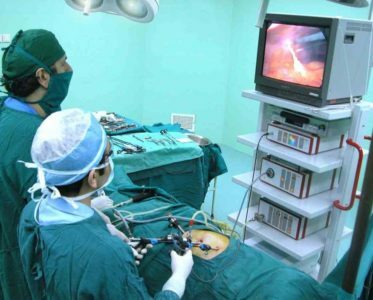
4 Laparoscopy method
Since the location of the appendix is constantly changing, the primary goal is to determine its exact location. Then it should be carefully separated from the inflamed areas, bandaged at the base and cut off. The amputated organ is extracted through one of the punctures on the walls of the peritoneum.
TIP FROM THE MAIN GASTROENTEROLOGIST
Korotov SV: "I can recommend only one remedy for the rapid treatment of Ulcer and Gastritis, which is now recommended by the Ministry of Health. .." Read the reviews & gt; & gt;
Special devices do not allow infection in the appendage to penetrate into the open wound. On average, the procedure lasts about 30 minutes. Operations are performed in a different order if complications exist. With peritonitis, suction of liquids and treatment of tissues with disinfectant solutions are performed. Complicated forms of appendicitis are characterized by the decomposition of the affected organ and subsequent suppuration of the surrounding tissues.
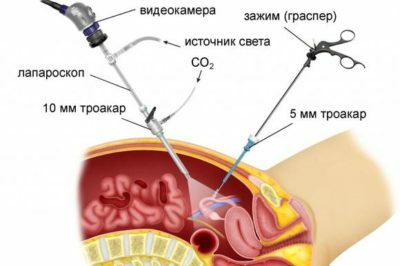
These processes require more careful operation in the operating field and detailed examination to avoid injury or hidden leakage of purulent fluid. But some surgeons believe that complicated appendicitis should be operated manually through the incision( diameter 15 cm).The presence of such beliefs is due to little experience in conducting laparoscopy. Doctors with a long history of working with a laparoscope can almost always successfully perform an operation to remove appendicitis even in a complicated form.
5 Rehabilitation and possible complications
The operation without complications lasts 48 hours, and after 8-10 days the seams are removed. Sometimes the patient is offered to impose cosmetic sutures that dissolve themselves. After 14-16 days, you can return to normal life.
WE RECOMMEND!
For prevention and treatment of Digestive Diseases our readers advise Monastic tea. This unique remedy consists of 9 medicinal herbs useful for digestion, which not only complement, but also enhance each other's actions. Monastic tea will not only eliminate all symptoms of the gastrointestinal tract and digestive system, but will also permanently eliminate the cause of its occurrence.
The opinion of doctors. .. "
Complications of appendectomy include infectious infection of the wound, which can manifest itself in different ways. For a mild form of inflammation, swelling and redness of the skin, which are easily copied by antibiotics. Severe complications with severe inflammatory processes require repeated surgical intervention with subsequent sanation. If necessary, the wound is not sutured, and the sanation is carried out repeatedly. In such cases, the stitches are superimposed after the infection is eliminated.
If the inflammation is localized in the abdominal cavity, an operation is necessary. Eliminate such a complication after surgery is possible by performing a puncture with ultrasound observation. Considering that appendectomy is considered one of the radical methods of therapy, the prognosis is good. After treatment or complications, the formation of scars or adhesions is allowed, which can adversely affect the functions of the gastrointestinal tract. The person has periodic pain, develops intestinal obstruction. For the prevention of complications it is recommended to undergo regular GI examination.
- 1 Essence of surgical procedure
- 2 Types of operations
- 3 Drainage implementation
- 4 Laparoscopy method
- 5 Rehabilitation and possible complications
Appendectomy is a surgical procedure for the removal of the appendix or appendix. It is indicated for acute or chronic appendicitis.



